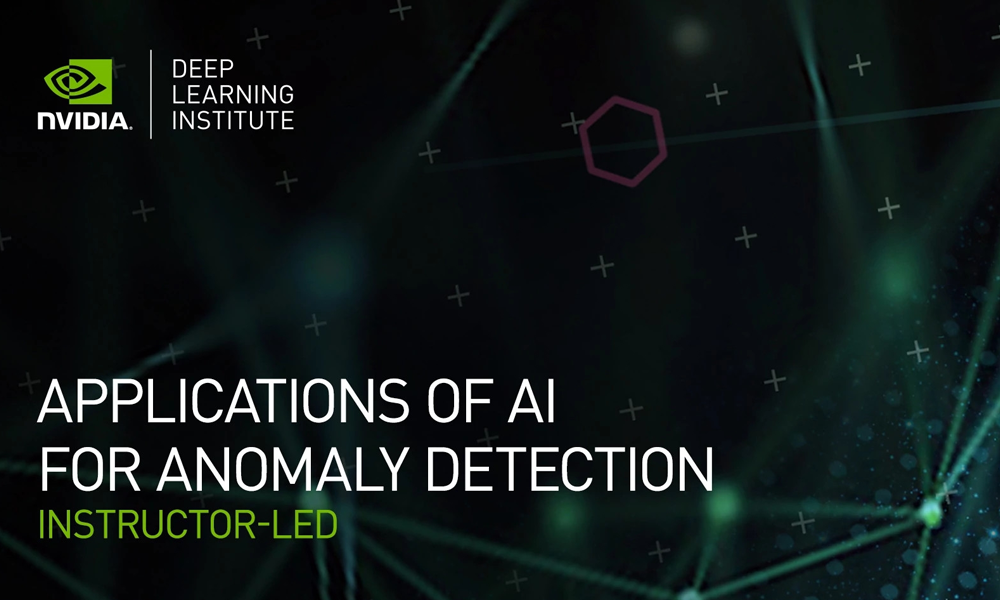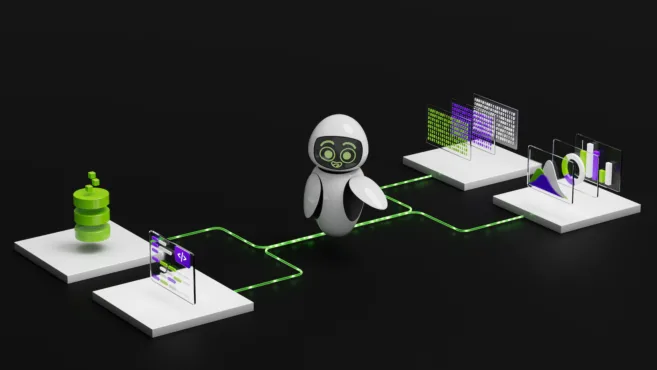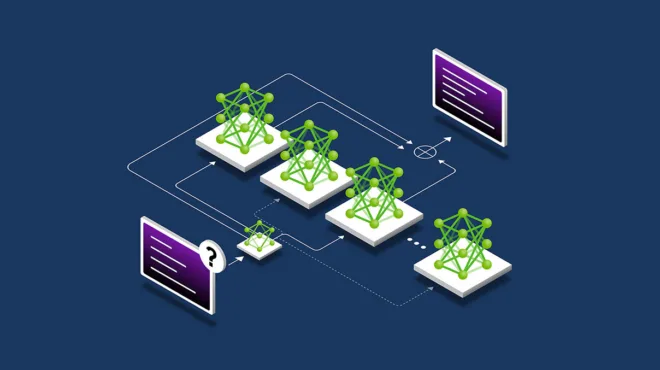In a recent blog post, we introduced NVIDIA NV-Tesseract, a family of models designed to unify anomaly detection, classification, and forecasting within a single framework. That work demonstrated the promise of tackling diverse time-series problems with a shared, general-purpose backbone.
NVIDIA NV-Tesseract-AD builds on this foundation but takes a more specialized path. Rather than relying only on transformers, it introduces diffusion modeling, stabilized through curriculum learning, and pairs it with adaptive thresholding methods in a model purpose-built for anomaly detection. Together, these elements address some of the most challenging issues in the field: noisy, high-dimensional signals that drift over time and contain rare, irregular events.
Equally important, NV-Tesseract-AD represents an evolution, not a reset. The first version of the model was confined to univariate datasets and often faltered in the presence of noise. Version 2.0 expands the architecture to handle multivariate inputs, uses curriculum schedules for reliable training, and incorporates adaptive thresholds to deliver greater robustness in real-world settings.
Why anomaly detection needs a rethink
Anomaly detection seems obvious: find unusual points in a data stream. But anyone who has worked with real-world time series knows it’s one of the most frustratingly complex problems in data science.
The challenge begins with non-stationarity. Few signals ever sit still. Semiconductor sensors drift as machines wear down. Patient vitals fluctuate in response to circadian rhythms, meals, and physical activity. Spacecraft telemetry looks completely different depending on whether a rover is cruising, drilling, or idling. Cloud KPIs surge during traffic spikes, fall quiet at night, and spike again during batch jobs. What appears anomalous at one moment may be entirely normal the next.
Then there’s noise and sparsity. Labels are rare and often unreliable. Ground-truth anomalies are expensive to capture. Operators can only label what they observe, and even domain experts may disagree on whether a fluctuation is a real fault or just natural variability. Many datasets are littered with false positives or miss the very failures we hope to detect.
For example, in nuclear power plants, thousands of sensors continuously track reactor pressure, coolant flow, and core temperature. Genuine anomalies—such as a small coolant leak or an early-stage pump failure—are rare, and a subtle pressure fluctuation might be dismissed as routine noise. If misclassified, it could conceal the early stages of a cascading failure that poses a threat to reactor safety.
Situations like this show a broader challenge across industries: sparse and unreliable labels make supervised learning prone to overfitting on a small, noisy dataset while overlooking critical patterns hidden in vast amounts of unlabeled data.
These problems became evident when NV-Tesseract-AD 1.0 was tested on public machine learning datasets, such as Genesis and Calit2. Both are notoriously noisy and sparsely labeled. Version 1.0, trained only on univariate signals, produced trivial detections or failed outright. What looked promising in toy settings crumbled when faced with the messiness of real-world data.
Key insights:
- Traditional statistical methods assume stability and collapse under drift or regime change.
- Even deep learning models falter when data is noisy, labels are sparse, or distributions shift.
- Generative methods, and especially diffusion models, open a new path by learning the manifold of “normal” behavior itself.
Diffusion models for time series
Generative diffusion models were originally designed for images, but their underlying principle maps elegantly to time series. Instead of reconstructing a signal in one shot, diffusion models gradually corrupt data with noise and then learn to reverse the process step by step. The result is a model that captures fine-grained temporal structure and can scale to hundreds or thousands of correlated signals (see arXiv:2508.06638 for methodological details, patent pending).
This iterative refinement is powerful. Subtle deviations—like a micro-variation in a patient’s heartbeat or a slight drift in a satellite’s battery voltage—are clear when the model learns the manifold of “normal” trajectories. Signals that can’t be denoised smoothly stand out as anomalies, not because they trip a hard threshold, but because they break the underlying structure of the data.
But diffusion comes with its own fragility. If training begins with tasks that are too complex, like fully corrupted signals or high masking ratios, the model may collapse into trivial reconstructions or fail to converge. NV-Tesseract-AD addresses this challenge with curriculum learning. Early training epochs focus on lightly corrupted inputs, where denoising is straightforward. Over time, noise and masking are gradually increased, forcing the model to master increasingly complex reconstructions.
This “easy-to-hard” progression stabilizes training, reduces variance in outcomes, and produces models that generalize more effectively once deployed. In practice, curriculum learning has been the difference between fragile experiments and systems that can handle the unpredictability of production data.

Segmented Confidence Sequences and Multi-Scale Adaptive Confidence Segments
Diffusion models generate anomaly scores. But those scores still need thresholds to drive decisions, and thresholds are often the weakest link. Static cutoffs fail when signals drift, as manufacturing tools recalibrate, patients transition from rest to activity, and networks fluctuate between peak and off-peak demand. In such environments, global thresholds either miss real anomalies or generate false alarms that overwhelm operators.
To address this, NVIDIA researchers developed two patent-pending methods—Segmented Confidence Sequences (SCS) and Multi-Scale Adaptive Confidence Segments (MACS). Both are unsupervised, model-agnostic, and grounded in confidence interval theory, making them interpretable and broadly applicable beyond NV-Tesseract-AD. These methods are part of the inference process, specifically during the threshold-setting stage of the anomaly detection pipeline, where they determine when a deviation should be considered significant.
SCS divides the time series into locally stable regimes, each with its own statistical baseline. Confidence bounds adapt within each regime, ensuring sensitivity where it’s needed and restraint where natural variance is high.

MACS examines data through short-, medium-, and long-term windows simultaneously. An attention mechanism weighs the most relevant scale, while a dual-detection rule reduces the number of spurious alerts. This allows MACS to capture quick bursts and gradual drifts without requiring separate detectors.

Together, SCS and MACS strike a balance that has long eluded anomaly detection: sensitive enough to catch subtle faults, yet disciplined enough to avoid overwhelming operators with noise.
Key insights:
- SCS adapts thresholds to locally stable regimes, improving recall while controlling false alarms.
- MACS views data at multiple timescales, capturing both bursts and drifts with fewer spurious alerts.
- Both are patent-pending NVIDIA innovations, unsupervised and interpretable, with applications beyond NV-Tesseract-AD.
From evaluations to real-world impact
Our evaluations weren’t about topping leaderboards. The question we asked was simpler: what happens when you apply diffusion techniques and adaptive thresholds to noisy, multivariate datasets?
As mentioned earlier, in our tests on the Genesis and Calit2 public datasets, the difference between the versions was stark. Version 1.0 produced trivial results or nothing at all. But version 2.0, with diffusion and adaptive thresholds, could separate actual structure from noise, surfacing anomalies that aligned with irregularities previously invisible to the system. The key difference wasn’t just accuracy, but also robustness: it maintained performance even under the very noise and sparsity that crippled older approaches.
That resilience translates directly into real-world situations. In healthcare, the problem isn’t the absence of anomalies but the flood of false alarms. Clinicians in an ICU can’t act on every minor fluctuation in vital signs. What they need is a system that learns patient-specific baselines, dynamically adapts thresholds, and surfaces only the deviations that matter. NV-Tesseract-AD demonstrates how this approach can reduce nuisance alerts, build clinician trust, and expedite responses when a genuine anomaly arises.
In aerospace, telemetry encompasses thousands of channels that vary significantly across different phases of a mission. A static threshold may swamp operators with alerts when a spacecraft changes mode, or worse, miss the subtle drift that precedes a critical failure. By combining diffusion modeling with adaptive thresholds, NV-Tesseract-AD shows how anomaly detection can distinguish between expected regime shifts and true anomalies—surfacing signals, such as unexpected torque variations in a rover wheel, before they become mission-ending.
In cloud operations, reliability hinges on monitoring a vast array of metrics, where both sudden spikes and long-term trends are crucial. Operators don’t just need alerts—they need alerts they can trust. Multi-scale thresholds allow NV-Tesseract-AD to flag a rapid burst of API errors without confusing it for a longer-term drift, or to catch a creeping memory leak that static thresholds would miss. The result is faster incident response and less noise in the dashboards that engineers depend on.
Key insights:
- Evaluations on noisy datasets, such as Genesis and Calit2, show how diffusion with thresholds outperforms v1.0.
- Real-world impact lies in reducing false alarms in healthcare, distinguishing regime shifts in aerospace, and filtering noise in cloud operations.
- The framework shows resilience to noise and drift, a prerequisite for trust in mission-critical settings.
A promising direction for the next generation of anomaly detection
Anomaly detection has always been one of AI’s most persistent challenges. Static rules fail in the face of drift, and even advanced deep learning models collapse in noisy, high-dimensional environments. NV-Tesseract-AD represents a shift in approach, combining diffusion modeling, curriculum learning, adaptive thresholds, and careful design refinements into a framework for developing more intelligent anomaly detection across industries.
Our evaluations show that when diffusion and adaptive thresholds are applied, anomaly detection systems become more resilient to noise, more capable of handling multivariate complexity, and more trustworthy in the eyes of operators. While broader evaluations and refinements are still ongoing, work to date suggests a promising direction for developing the next generation of anomaly detection systems.
Get started with NV-Tesseract-AD
NV-Tesseract-AD will be available initially through a customer preview under an evaluation license, offering a first look at its advanced time-series modeling capabilities. Users can bring their own datasets, run diffusion-based anomaly detection with curriculum learning and adaptive thresholds, and adjust detection sensitivity to meet their needs. The system scales seamlessly from proof of concept to exploratory production trials and integrates into existing MLOps pipelines and detection methods.
Contact the NVIDIA DGX Cloud team to schedule a demo, discuss your time-series requirements, and explore how NV-Tesseract-AD can become a cornerstone of your anomaly detection workflow.
Attending SEMICON West Oct 7-9, 2025? Check out our session, “Time Series modeling for Smart Manufacturing & Predictive Maintenance” on Thursday, October 9.








